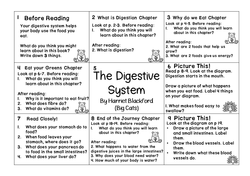
One of the ideas I got from this twilight course was using 'Task Mats', and I wrote about it earlier on this blog. I've been using them ever since, and they've been a great way to get kids working on a variety of different reading comprehension tasks throughout the week. I've finally got my last group to the stage where they are ready to start looking at a simplified version of task mats - all very exciting.
Most of the kids are doing reasonably well with reading fiction texts. Having a story structure to hang their understanding of what they are reading on is so helpful.
But when we come to non-fiction, story structure obviously isn't there. And as we moved into more challenging non-fiction texts, I was finding that my class was struggling to tell me what they'd read. I could ask them questions, and they could happily use an index or table of contents to find the answer. BUT - if you asked them what the book was about, or asked for a general overview of a page or two, they were lost. Not good.
So we've been slowing down a LOT. Using the Reading Comprehension Animals I've blogged about, we've been focusing on 'Predicting Panda' and 'Wondering Walrus' as we look at how to understand and remember non-fiction.
Before we read, we look at the title of our book and the blurb on the back. Then we predict: What do we think we are going to learn about in this book?
On turning to the first chapter, we stop before we read. Using the title and the pictures this time, we predict again - what do we think we are going to learn about in this chapter? When reading non-fiction, I found that my kids wanted to skip the title, barely glance at the pictures, and completely ignore the picture captions - despite the fact that so much of the information in the text was contained in those elements. Their focus was on how fast they could read, rather than how well they could understand.
But when we started to stop and predict before reading, this activated any prior knowledge the children had, as well as helping them to focus in on what they should be learning.
After predicting 'what we will learn', we read the chapter. Once we have finished, we stop again (this has been the key, I think - getting them all to slow down!), and we ask ourselves (we 'wonder') - were my predictions right? Have a learned something else other than what I predicted? What have I learned?
This procedure forces them to check that they've understood, and that they can offer some kind of summary of the information they've just read. It's been a slow process, but I'm beginning to see more understanding when I'm asking general questions during small group reading. They are also getting better at using the title and pictures to focus in on what each chapter is likely to be about, so their predictions are getting better.
Along with small group reading, we've also been reading The Magic Tree House Viking non-fiction companion book as a whole class when we have a spare 10 minutes at different points throughout the day (we are studying the Vikings this term). We've again been using our 'predict, read, wonder/question' cycle to help us understand what our text is telling us about the Vikings. This has given me a good opportunity to model this comprehension cycle using a non-fiction topic the whole class is really enjoying (and has reasonable prior knowledge about).
I've made the Task Mat above 'clickable', so you can download it to have a closer look if you want. Because I'm using the Reading Comprehension animals to teach the strategies, I have put a picture of the relevant animal on the task mats I'm using. The version I'm uploading doesn't have those pictures, however (the pictures are bought clipart, so I cannot upload them to the web in an unsecured form). By taking the pictures out, though, I've been able to leave the Task Mat as a Powerpoint file (rather than turning it into a PDF). That means that you will be able to edit it to make it suitable for the books your class are reading, if you'd like to give the Task Mat idea a try.
If anyone has any ideas for helping kids understand non-fiction, I'd love to hear them. It's such a different reading skill than understanding a narrative text, and I know it can be quite tricky for a lot of our kiddos.

 RSS Feed
RSS Feed